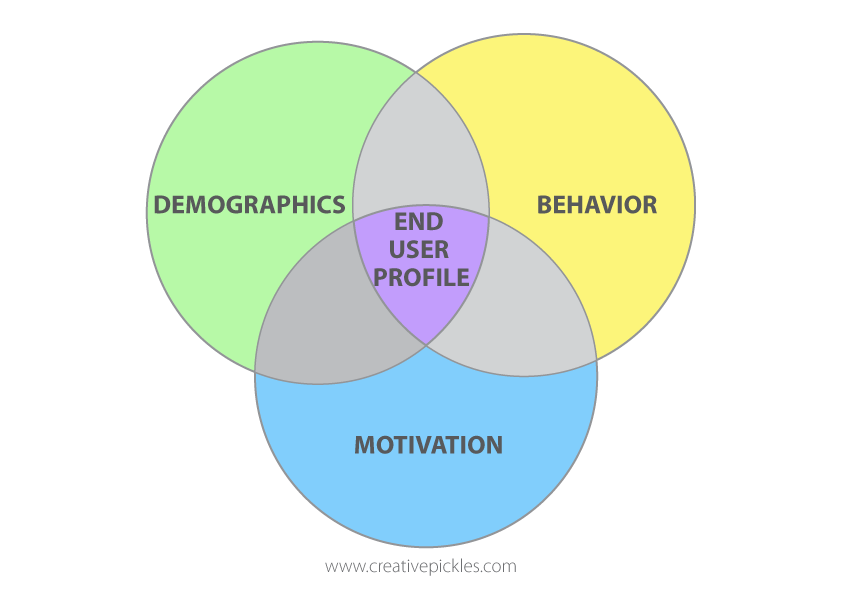A process for defining an end user profile and answer the question “Who am I targeting?”
Ever heard the phrase “If you’re talking to everybody, you’re in fact talking to nobody”? If you’ve met with a marketing person, one of the very first things they will ask is “Who’s your customer? Who are you targeting with your product?”. And, at that point, you might be tempted to say “Everyone”. This is where you’ll see their eyes roll, and here’s why.
As a business owner, you need to define your end-users, the narrow group of people who have similar needs, similar characteristics, and who talk among themselves.
Let’s take a home furniture store as an example and imagine I’d start a conversation with Charlotte, the owner. Charlotte launched her business, has some potential customers coming in, but sales are slow and she needs more qualified leads to visit her store.
If I were to ask about her customers, she might say: “Every person out there is a customer. Don’t we ALL have furniture in our homes?”. And she’d be right. Unless you’re an eskimo living in an igloo 🙂
But let’s think about this: how would I advertise Charlotte’s business to men and women, aged 18-99, married or single, urban or rural environments, all income levels? Would that be effective? What would you even write in such an ad? “Please visit our store. High-quality furniture for everyone. Great prices!”. That’s not money well spent.
By talking to Charlotte, I find out that more women than men visit her store. Women seem to be more interested in furniture, interior decoration and they have the final say. We already add our first criteria to the list: women. Going further with our thinking, in this type of business, a customer does not come back every month or every year to buy more products. Charlotte should invest her money in targeted ads at the right time, when specific life events occur.
Top of the head ideas: her potential client buys furniture after getting married and moving into a new home with her partner or when she’s pregnant.
Let’s imagine Ava is a young, 25 year old bride and Mia is a 32 year old expecting mother. Are the needs the same? Would I address Ava and Mia with the same message and images? Not really.
Ava might want modern furniture, new designs, fresh colors. She might work from home, so, she could be looking for modular desks that she can mix & match and an ergonomic chair.
On the other hand, Mia is interested in safety and function, above all. She’s looking for a crib with built-in drawers, an organic mattress, and a changing table with guardrails.
Ava won’t respond to an ad with a crib selection and Mia won’t bother to look twice at a post containing the latest tips on how to style your home-office. Different needs and different sales process.
We could add Alice in the mix, as a third type of end user. She is pregnant with her 3rd child, so what Mia wants might not be suitable for Alice. Alice already has the basics, but she needs to think about reorganizing the entire space, look for bunk beds, and ideas for the study space of her eldest.
This was a simple scenario, that should get you to start thinking about how you do the segmenting and targeting. No matter the business you’re in, here’s a process you should use to define your end user profile. Start with the 3 main categories: demographics, behaviour and motivation.
Demographic segmentation can be based on gender, age, income level, location. This tells you who to target.
Behavior questions: where are they, when they’re not working? Where do they go out to eat? What are they reading? What websites do they visit? Are they in any Facebook group? This gives you a hint on where you can best reach them with your message.
Motivation: what excites them, what are they looking for, is there anything they fear? This tells you what you should include in your message, how to address them and how to craft a compelling copy.
If you answer the above, you will have a clear picture of who to target and who you can disqualify. This is not an 100% complete list of questions, but it’s a decent start. Apply lean methodologies principles: start with a hypothesis, choose one profile to focus on, take action, learn, repeat.
After a few iterations, you will discover customers willing to pay for what you offer and you will be able to build a great business around their needs.
Good luck and let us know how it goes! Comment below or post on our Facebook page.
Guest Blog post by: Helen Pickles from Creative Pickles
About Helen
Helen has been working in the IT Software industry for more than 10 years. She has a Bachelor’s Degree in Computer Science and a Certificate of Entrepreneurial Competencies. Together with two talented designers, she co-founded “Creative Pickles”, an agency that helps entrepreneurs build their online presence. Starting from logo design to websites and online marketing strategy & tactics, the Creative Pickles provide customized solutions for businesses that need a professional digital presence.
You can find out more on their website: http://www.creativepickles.com or their Facebook page: https://www.facebook.com/creativepickles.




